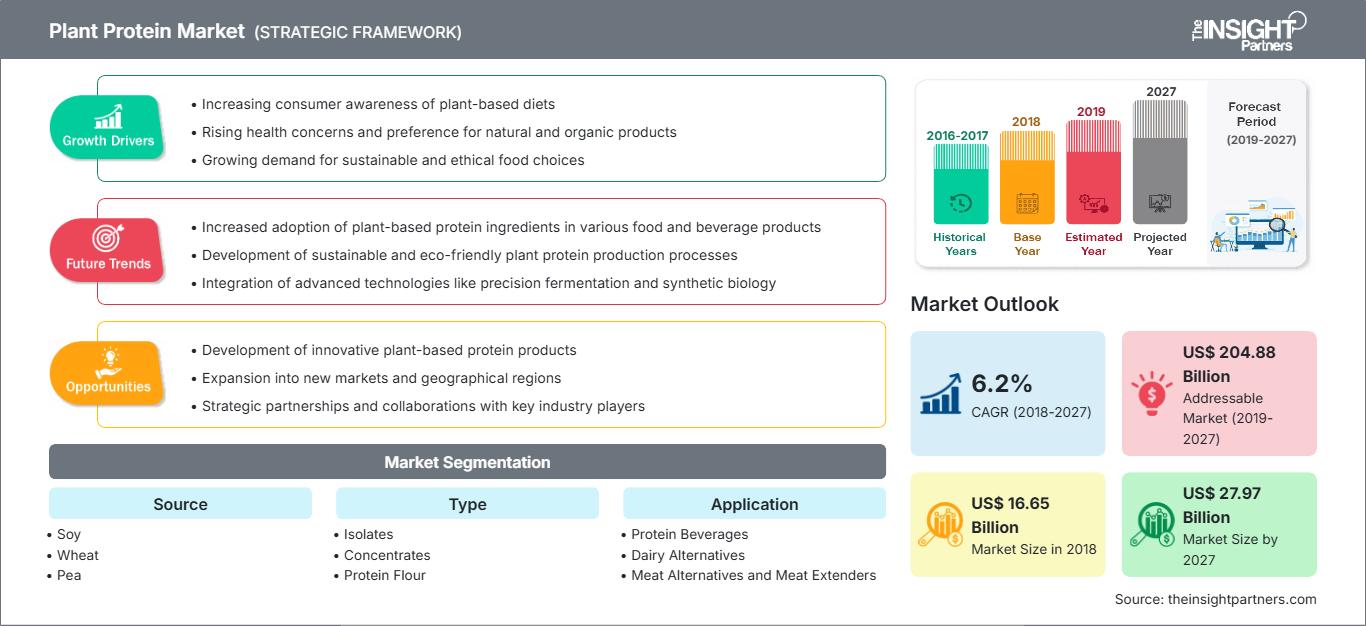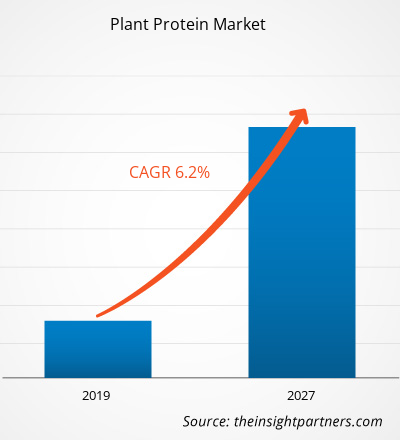Il mercato delle proteine vegetali è stato valutato a 16.653,6 milioni di dollari nel 2018 e si prevede che raggiungerà i 27.965,9 milioni di dollari entro il 2027; si prevede una crescita a un CAGR del 6,2% dal 2019 al 2027.
Le proteine sono nutrienti vitali necessari al corpo umano e sono costituite da amminoacidi. Le proteine vegetali si ottengono da varie fonti vegetali come soia, grano, piselli, noci e semi, tra gli altri. Diverse fonti vegetali come lenticchie, ceci, arachidi, mandorle, spirulina, quinoa e semi di chia forniscono un'elevata quantità di proteine. Poiché le proteine vegetali sono ipocaloriche, possono essere consumate come sostituti delle proteine animali per la perdita di peso. La crescente domanda di alimenti di origine vegetale, unita al crescente interesse dei consumatori per gli alimenti ad alto contenuto proteico, è il fattore chiave che stimola la crescita della domanda di proteine vegetali a livello globale.
Si prevede che la crescita del mercato delle proteine vegetali nell'area Asia-Pacifico (APAC) raggiungerà il CAGR più elevato durante il periodo di previsione. La crescita del mercato delle proteine vegetali in questa regione è principalmente attribuibile all'aumento del reddito disponibile, con i cambiamenti negli stili di vita che rappresentano i principali fattori trainanti per le proteine vegetali nell'area Asia-Pacifico. La rapida crescita del settore alimentare e delle bevande nei paesi asiatici sviluppati e in via di sviluppo come Cina, India e Giappone offre un'enorme opportunità di mercato per i produttori di proteine vegetali, poiché sono ampiamente utilizzate in prodotti come bevande proteiche, alternative ai latticini, alternative alla carne e barrette proteiche.
L'aumento del reddito disponibile delle persone nei paesi sviluppati e in via di sviluppo come India, Cina e Australia ha portato a un'enorme domanda di proteine vegetali in questa regione.
Personalizza questo rapporto in base alle tue esigenze
Potrai personalizzare gratuitamente qualsiasi rapporto, comprese parti di questo rapporto, o analisi a livello di paese, pacchetto dati Excel, oltre a usufruire di grandi offerte e sconti per start-up e università
Mercato delle proteine vegetali: Approfondimenti strategici

-
Ottieni le principali tendenze chiave del mercato di questo rapporto.Questo campione GRATUITO includerà l'analisi dei dati, che vanno dalle tendenze di mercato alle stime e alle previsioni.
Market Insights: crescente consapevolezza dei consumatori sugli alimenti ricchi di proteine per alimentare la crescita del mercato delle proteine vegetali
Le proteine svolgono un ruolo chiave nel trasporto delle molecole in tutto il corpo, contribuendo alla riparazione cellulare e proteggendo l'organismo da virus e batteri. Promuovono inoltre una crescita e uno sviluppo adeguati nei bambini, negli adolescenti e nelle donne in gravidanza.
Diversi studi dimostrano che una dieta ricca di proteine aiuta ad aumentare la massa muscolare e la forza e previene la perdita di massa muscolare durante la gestione del peso o un programma di dimagrimento.
Le persone che consumano più proteine tendono a mantenere meglio la massa ossea e hanno un rischio molto più basso di osteoporosi e fratture. Un elevato apporto proteico ha portato a un aumento del metabolismo che si traduce in un maggiore consumo di calorie. Questo aiuta ulteriormente a una corretta gestione del peso e alla perdita di peso. Questi benefici delle proteine stanno attirando i consumatori verso alimenti e bevande ricchi di proteine disponibili sul mercato. Ciò crea un'ulteriore enorme domanda di proteine vegetali a livello globale.
Un alimento ricco di proteine è considerato uno dei trend più forti nel settore alimentare e delle bevande. Seguendo la tendenza proteica negli alimenti, i produttori di alimenti e bevande stanno cercando di realizzare prodotti alimentari nutrizionali. La crescente consapevolezza dei consumatori riguardo a metodi efficaci per perdere peso, contrastare l'invecchiamento e altri problemi di salute attraverso il consumo di alimenti ricchi di proteine sta aumentando la domanda di proteine vegetali. Inoltre, le crescenti tendenze in materia di salute e benessere hanno creato una forte domanda di alimenti e bevande funzionali e fortificati negli ultimi anni. Pertanto, si prevede che la crescente consapevolezza dei consumatori riguardo agli alimenti ricchi di proteine alimenterà la crescita del mercato delle proteine vegetali.
Approfondimenti basati sulla fonte
In base alla fonte, il mercato delle proteine vegetali è suddiviso in soia, grano, piselli e altri. Il segmento della soia ha rappresentato la quota di mercato maggiore nel 2018; tuttavia, si prevede che il segmento dei piselli registrerà il CAGR più elevato del mercato durante il periodo di previsione. L'isolato proteico di soia è una forma altamente raffinata di proteine di soia, con un contenuto proteico minimo del 90%. È prodotto da farina di soia sgrassata, da cui vengono rimossi la maggior parte dei componenti non proteici, inclusi grassi e carboidrati. Le proteine di soia in polvere sono prodotte da fiocchi di soia sgrassati, lavati in alcol o acqua per rimuovere zuccheri e fibre alimentari. Vengono quindi disidratati e macinati in polvere. Le proteine di soia in polvere vengono utilizzate per preparare latte artificiale a base di soia per neonati, nonché una varietà di alternative a carne e latticini. I concentrati proteici di soia contengono in genere il 70% di proteine di soia e sono fondamentalmente farina di soia sgrassata senza carboidrati idrosolubili. Questa forma di proteina è prodotta rimuovendo parte dei carboidrati dai semi di soia decorticati e sgrassati. La farina di soia si ottiene macinando i semi di soia fino a ottenere una polvere fine.
Approfondimenti basati sulla tipologia
In base alla tipologia, il mercato delle proteine vegetali è segmentato in isolati, concentrati e farine proteiche. Il segmento dei concentrati ha rappresentato la quota di mercato maggiore nel 2018. I concentrati di proteine vegetali vengono prodotti estraendo proteine da varie fonti come soia, grano, piselli, quinoa, avena, fagioli e frutta secca. Questi in genere forniscono il 60-80% di proteine, mentre il restante 20-40% è composto da grassi e carboidrati. Le proteine vegetali concentrate sono il tipo di polvere proteica meno elaborato. Le proteine vegetali in forma concentrata aiutano i muscoli a recuperare rapidamente da un esercizio fisico intenso, poiché vengono assorbite rapidamente dall'organismo. Pertanto, la facile reperibilità dei concentrati di proteine vegetali, unita ai prezzi più bassi rispetto agli isolati di proteine vegetali, sono i fattori chiave che stimolano il mercato. I concentrati di proteine vegetali tendono a essere l'opzione più economica, ma offrono la quantità minore di proteine rispetto agli isolati di proteine vegetali perché contengono una maggiore quantità di altri ingredienti. Questi ingredienti aggiuntivi possono includere grassi, colesterolo, lattosio e glutine. I consumatori che cercano di limitare l'assunzione di grassi o hanno un apparato digerente sensibile dovrebbero evitare i concentrati di proteine vegetali.
Approfondimenti basati sulle applicazioni
In base alla tipologia, il mercato delle proteine vegetali è segmentato in bevande proteiche, alternative ai latticini, alternative alla carne e integratori di carne, barrette proteiche, prodotti da forno e altre applicazioni. Il segmento delle alternative alla carne e degli integratori di carne ha rappresentato la quota di mercato maggiore nel 2018. I prodotti alternativi alla carne includono tofu, tempeh, proteine vegetali testurizzate, seitan e Quorn, tra gli altri. Questi prodotti hanno sapore, aspetto e consistenza simili a quelli di pollame, carne e prodotti ittici. Sono prodotti utilizzando ingredienti a base di cereali e piante per sostituire proteine e minerali di origine animale (in particolare calcio), che aiutano a ridurre i livelli di colesterolo, prevenendo i disturbi della menopausa e altri disturbi correlati. Le proteine vegetali sono ampiamente utilizzate nella produzione di alternative alla carne. Fagioli e legumi sono fonti convenienti di proteine vegetali che fungono da sostituti della carne. Anche la soia è tra le principali fonti per la produzione di alternative alla carne. Gli isolati proteici di piselli sono utilizzati principalmente da produttori di alternative alla carne come Daiya, Gardein, Ben & Jerry's, Beyond Meat, Just Mayo e Ripple Foods, tra gli altri. Pertanto, l'aumento della domanda e della produzione di alternative alla carne si traduce in una maggiore domanda di proteine vegetali. La domanda di alternative alla carne è in aumento a causa delle crescenti preoccupazioni per la salute dei consumatori e della crescente preferenza per il cibo vegano. Inoltre, l'aumento dei livelli di obesità dovuto al consumo di carne e prodotti a base di carne ha portato a una crescente preferenza dei consumatori per i sostituti della carne.
Alcuni attori che operano nel mercato delle proteine vegetali sono Archer Daniels Midland Company; Axiom Foods, Inc.; Burcon NutraScience Corporation; Cargill, Incorporated; EI Du Pont De Nemours and Company; Glanbia plc; Ingredion Incorporated; Kerry Group; Koninklijke DSM NV; e Roquette Frères. Le aziende chiave implementano fusioni e acquisizioni, nonché strategie di ricerca e sviluppo per espandere la propria base clienti e acquisire quote significative nel mercato globale, il che consente loro anche di mantenere il proprio marchio a livello globale.
Mercato delle proteine vegetaliLe tendenze regionali e i fattori che influenzano il mercato delle proteine vegetali durante il periodo di previsione sono stati ampiamente spiegati dagli analisti di The Insight Partners. Questa sezione illustra anche i segmenti e la geografia del mercato delle proteine vegetali in Nord America, Europa, Asia-Pacifico, Medio Oriente e Africa, America meridionale e centrale.
Ambito del rapporto sul mercato delle proteine vegetali
| Attributo del rapporto | Dettagli |
|---|---|
| Dimensioni del mercato in 2018 | US$ 16.65 Billion |
| Dimensioni del mercato per 2027 | US$ 27.97 Billion |
| CAGR globale (2018 - 2027) | 6.2% |
| Dati storici | 2016-2017 |
| Periodo di previsione | 2019-2027 |
| Segmenti coperti |
By Fonte
|
| Regioni e paesi coperti |
Nord America
|
| Leader di mercato e profili aziendali chiave |
|
Densità degli operatori del mercato delle proteine vegetali: comprendere il suo impatto sulle dinamiche aziendali
Il mercato delle proteine vegetali è in rapida crescita, trainato dalla crescente domanda da parte degli utenti finali, dovuta a fattori quali l'evoluzione delle preferenze dei consumatori, i progressi tecnologici e una maggiore consapevolezza dei benefici del prodotto. Con l'aumento della domanda, le aziende stanno ampliando la propria offerta, innovando per soddisfare le esigenze dei consumatori e sfruttando le tendenze emergenti, alimentando ulteriormente la crescita del mercato.

- Ottieni il Mercato delle proteine vegetali Panoramica dei principali attori chiave
In evidenza nel rapporto
- Tendenze progressive del settore nel mercato delle proteine vegetali per aiutare gli operatori a sviluppare strategie efficaci a lungo termine
- Strategie di crescita aziendale adottate dai mercati sviluppati e in via di sviluppo
- Analisi quantitativa del mercato delle proteine vegetali dal 2018 al 2027
- Stima della domanda globale di proteine vegetali
- Analisi PEST per illustrare l'efficacia di acquirenti e fornitori che operano nel settore
- Sviluppi recenti per comprendere lo scenario competitivo del mercato
- Tendenze e prospettive di mercato, nonché fattori che guidano e frenano la crescita del mercato delle proteine vegetali
- Assistenza nel processo decisionale evidenziando le strategie di mercato che sostengono l'interesse commerciale, portando alla crescita del mercato
- Dimensioni del mercato delle proteine vegetali in vari nodi
- Panoramica dettagliata e segmentazione del mercato, nonché del settore delle proteine vegetali dinamiche
- Dimensioni del mercato delle proteine vegetali in diverse regioni con promettenti opportunità di crescita
- Analisi storica (2 anni), anno base, previsione (7 anni) con CAGR
- Analisi PEST e SWOT
- Valore/volume delle dimensioni del mercato - Globale, Regionale, Nazionale
- Industria e panorama competitivo
- Set di dati Excel
Report recenti
Testimonianze
Motivo dell'acquisto
- Processo decisionale informato
- Comprensione delle dinamiche di mercato
- Analisi competitiva
- Analisi dei clienti
- Previsioni di mercato
- Mitigazione del rischio
- Pianificazione strategica
- Giustificazione degli investimenti
- Identificazione dei mercati emergenti
- Miglioramento delle strategie di marketing
- Aumento dell'efficienza operativa
- Allineamento alle tendenze normative






















 Ottieni un campione gratuito per - Mercato delle proteine vegetali
Ottieni un campione gratuito per - Mercato delle proteine vegetali